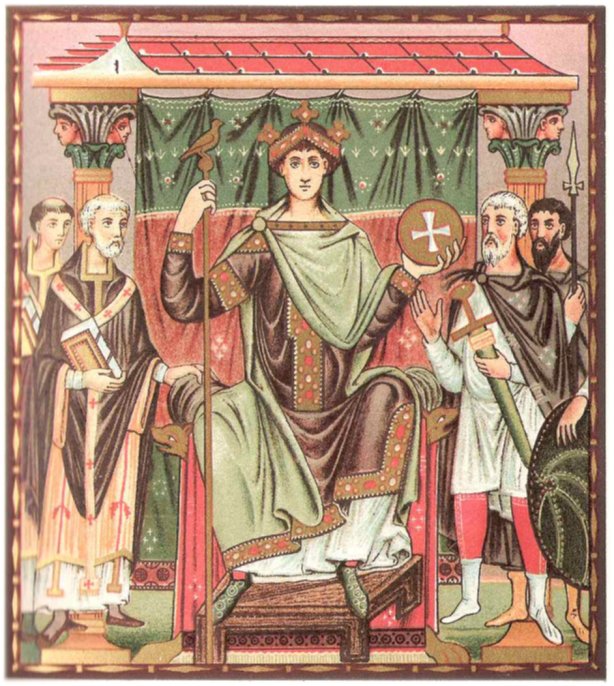The enforced Millennium – no way to ignore Charlemagne!
Let us suppose, the 'purging of the centuries'
Leo
of Vercelli had requested was put into effect immediately after the
death of Gregory V. by the new pope
Silvester II. (
Gerbert
of Aurillac) – one year late, however. Now it became necessary, to
implement the new year-count reference efficiently and quiet (At least
the Holy Father will have realized that a reform like this had the
potential
to escalate into an uncontrollable religious conflict).

Early in the year 1000 C.E. the
Emperor Otto III. visited
Aachen. There
he uncovered the relics of his ancester Càrolus, who had passed away
186 years before. Otto removed the burial objects and extracted a tooth
from the skull. He replaced the missing nose of the dead by a gold
sheet, before he left the crypt. An intense description of the events
at Aachen has been preserved within the chronicle of the
piemontenian monastery at Novalese, supposedly based on an eye-witness
report:
"Nach vielen Jahren kam Kaiser Otto III. in die Gegend, wo
Karls Leichnam geziemend begraben ruhte. An den Ort des Begräbnisses
stieg er zusammen mit zwei Bischöfen und dem Grafen Otto von Lomello
hinab. Der Kaiser selbst war der vierte. Jener Graf erzählte die Sache
folgendermaßen: Wir traten bei Karl ein. Er lag nämlich nicht, wie
üblicherweise die Leiber anderer Verstorbener, sondern er saß wie
lebendig auf einem Thron, war mit einer goldenen Krone gekrönt, hielt
das Szepter in den Händen mit angezogenen Handschuhen, durch die
bereits die Fingernägel durchbohrend herausgewachsen waren. Über ihm
war ein aus Kalk und Marmor ziemlich gut gebautes Gewölbe. Wir
beschädigten es beim Hinkommen, indem wir ein Loch hineinbrachen. Als
wir dann zu ihm eintraten, nahmen wir einen sehr starken Geruch wahr.
Mit gebeugten Knien richteten wir sofort ein Gebet an ihn. Kaiser Otto
bekleidete ihn dann mit weißen Gewändern, beschnitt ihm die Nägel und
stellte alles Abgefallene um ihn wieder her. Nichts von seinen Gliedern
war bis dahin durch Verwesung vernichtet, nur von seiner Nasenspitze
fehlte ein wenig. Sie ließ der Kaiser sogleich aus Gold ergänzen und
ging dann weg, nachdem er aus (Karls) Mund einen Zahn gezogen und das
Gewölbe wieder hatte herstellen lassen" [Chronicon Novaliciense, ed.
Gian Carlo Alessio. Torino 1982, III 32, S.182; Übersetzung: Görich
S.383 in 'Herrschaftsrepräsentation im ottonischen Sachsen' (Vorträge
und Forschungen 46). Sigmaringen 1998]
A visit within the lost and rediscovered tomb
facing the upright sitting mummy of Charlemagne... – this may sound
quite a bit overdone. But who could conceive the detail with the missing
nose-tip? His 'Charles' would have been inevitably disqualified as a
ruler (let's just recall the fate of Justinian II. 'Rhinometos'
)!
There are just two explanations: The nose of the death was indeed
missing - In this case, Otto III. had found and opened the real grave
of
his forefather Càrolus Nazon (*480 †516 – 'Charly the Nose').
Alternatively, Otto new about the missing nose, possibly from records
within his
family – likewise an argument for the physical existence of Càrolus
(Interesting to know: Although son of a king, Càrolus was the only
possible candidate for the succession of king Clovis the Great who
was not
killed
within the purge of 510 A.D.).
What was the intention behind this ghoulish
spectacle? It did generate
'evidence' for the newly set year-count scheme! Of course, a 'Mighty
Charlemagne' could not rule before the decline of the Merowingians.
But if Charles was real, all events and persons that were dated the old way referring to the
incarnation of the Lord were thus shifted into past times long ago.
In order
to leave no room for whatsoever doubts about the validity of the
year-cont, the sheer existence of Charlemagne was pretendend. In
addition, to create ultimate credibility, events and doings of other
rulers were assigned to 'Charles':
1. Austrapius, the last Charl (king) of the Menapian people
- gave his title and his name.
2. Carolus Nazon - provided the corpse (nose), year of death (A.D.),
ancestry.
3. Chlovis I. - did the conquest of the Francian empire.
4. Theoderic I. - conquered Italy and moved into Rome [800
C.E.]
5. Chlothar I. - subjected and christianized the Saxons.
6. Charles III. Simplex - used the KRLS-Signature and the coins
assigned to
'Charlemagne'.
7. Otto I. - obtained the ointment as emperor by the Pope at Rome.
One thing to maintain was the
descendance of Charlemagne (and of Otto III.) from the Menapian rulers
that was explaining
likeweise the ascent of the Carolingian dynasty. This could be
provided
without attracting attention by a fabricated (Fredegar-)
chronicle
identifying Pippin the Old with Pippin of Landen, the
descendant of the Menapians. The latter, so the chronicle, had
installed Chlothar II. on the throne. His descendents then
served the
Merovingian kings as mayor domus (chancellor) and, ultimately,
they themselves became the rulers...
No more action was required, in order to manipulate the chronology of
the occidental world! The rest may be called 'self-organization':
-
Between Pippin the Old and
Charlemagene some
128 years remained, where other regents must have ruled. The existing
records named – just Pippin and Charles. So these
names were repeated by chronologists to fill the non-existant gap.
-
As the life-times of 'Charlemagne' and Clovis
overlapped, Louis the Pious, his clone had to become
the
successor of Charles. However, the 2nd wives of Clovis and Ludwig had
virtually identical biographies and family structure and died at Tours
(separated by 299 virtual years).
-
Many A.D.-year-numbers were 'corrected'
following
the laws of logics: Recalculation of weekdays led to a deviation of 297
years, the roman Indiction cycle suggested 300 years. Easter
calculus
repeats after 304 years (i.e. 4 callippic cycles), and so on...
In addition, glorifying court traditions,
literary fancifulness, make-belive of individual and church possesions,
fraud and greed led
to many false documents and traditions. So far, there has been no doubt
about
these motivations and their influence...
HEK 12/08

